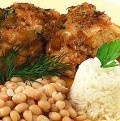Cuban cuisine has been influenced by Spanish, French, African, Arabic, Chinese, and Portuguese cultures. Traditional Cuban cooking is primarily peasant cuisine that has little concern with measurements, order and timing. Most of the food is sauteed or slow-cooked over a low flame. Very little is deep-fried and there are no heavy or creamy sauces. Most Cuban cooking relies on a few basic spices, such as garlic, cumin, oregano, and bay laurel leaves. Many dishes use a sofrito as their basis. The sofrito consists of onion, green pepper, garlic, oregano, and ground pepper quick-fried in olive oil. The sofrito is what gives the food its flavor. It is used when cooking black beans, stews, many meat dishes, and tomato-based sauces. Meats and poultry are usually marinated in citrus juices, such as lime or sour orange juices, and then roasted over low heat until the meat is tender and literally falling off the bone. Another common staple to the Cuban diet are root vegetables such as yuca, malanga, and boniato, which are found in most Latin markets. These vegetables are flavored with a marinade, called mojo, which includes hot olive oil, lemon juice, sliced raw onions, garlic, cumin, and little water.
A typical Cuban breakfast consists of a tostada and cafe con leche. The tostada is a portion of Cuban bread which is buttered then toasted on an electric grill. The cafe con leche is a combination of strong, espresso coffee with warm milk. Cubans break the tostada into pieces, then dunk them into the cafe con leche, as Americans would dunk their doughnuts into their coffee. Additionally, some may eat ham croquetas, smoky creamed ham shaped in finger rolls, lightly breaded, and then fried. For those on the run, with no time or desire to eat, a shot of cafe cubano, Cuban coffee, will revive the dead.
Lunch consists of empanadas, chicken or meat turnovers, or cuban sandwiches. The sandwich could be a media noche (midnight sandwich), consisting of a slice of pork, ham, and swiss cheese and then topped with pickles and mustard on sweetened egg bread. The pan con bistec is a thin slice of palomilla steak on Cuban bread garnished with lettuce, tomatoes, and fried potato sticks. One may also order a side of mariquitas, thinly sliced plantain chips, to accompany their hearty sandwich.
For snack time, Cuban bakeries are famous for their finger foods, such as pastelitos, croquetas, bocaditos, and empanadas. Pastelitos are small flaky turnovers in various shapes filled with either meat, cheese, guava, or a combination of guava and cream cheese. Bocaditos are small bite size sandwiches layered with a ham spread.
Dinner will usually consist of a meat, chicken, or fish dish as the entree accompanied by white rice, black beans, and maduros, sweet fried plantains. At times, a small salad of sliced tomatos and onions or avocados might be added to the meal. The meal is followed by dessert, such as the typical flan, a Cuban caramel-flavored custard, and another shot of cafe cubano. Other equally popular alternatives for dessert are bread or rice puddings.
For holidays or special occasions, the one dish that typifies Cuban cuisine would be a small pig, marinated with salt, garlic, and sour orange juice, and then roasted over an open fire, and slowly cooked for several hours. The accompaniments for such a dish could consist of congri, a white rice and black bean mixture also known as Moors and Christians, boniato in a garlic dressing, and maduros. For refreshments, the most typical drinks are the daiquiri and the mojito. Both are made with lime juice and pure cane rum.

